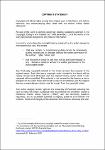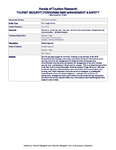Tourist Perceived Destination Innovativeness (TPDI) and its Impacts on Tourist Experience and Tourist Satisfaction -The Case Study of Hunan (China)
| dc.contributor.supervisor | Wai Mun, Lim | |
| dc.contributor.author | Yang, Xiaoshan | |
| dc.contributor.other | Faculty of Arts and Humanities | en_US |
| dc.date.accessioned | 2024-04-05T13:03:21Z | |
| dc.date.available | 2024-04-05T13:03:21Z | |
| dc.date.issued | 2024 | |
| dc.identifier | 10592236 | en_US |
| dc.identifier.uri | https://pearl.plymouth.ac.uk/handle/10026.1/22237 | |
| dc.description.abstract |
The primary purpose of this study is to develop a comprehensive understanding of tourist perceived destination innovativeness (TPDI) and to assess its impacts on tourist experience and satisfaction, and the thesis accordingly develops a multidimensional scale for measuring the concept of destination innovativeness. TPDI in this study refers to the willingness and capability of a destination to provide and deliver unique, interesting service and product. The development and validation of the multidimensional scale for the concept followed a rigorous procedure with three different stages of study, the data for which was collected from tourists in Hunan. The first stage analysed qualitative data from 30 interviews using a thematic analysis technique. In the second stage, the exploratory factor analysis (n=522) was used to purify and refine the scale generated in the first stage. The last stage of the study used confirmatory factor analysis (n=748) to validate the 20 item-scale for destination innovativeness. The study developed a model with one higher order factor (TPDI), and five corresponding lower order factors (destination co-creation innovativeness, destination development innovativeness, destination experiential innovativeness, destination inclusiveness innovativeness and destination marketing innovativeness). Moreover, the impacts on tourist experience and satisfaction were assessed using the data from the third stage, which were confirmed by SmartPLS. The thesis highlights the positive relationship of TPDI on tourist experience and tourist satisfaction. Moreover, the study reveals that the tourist experience acts as a mediation role between TPDI and tourist satisfaction. The results indicate that an innovative destination needs to consider tourist perception as a whole, and not only new products and unique promotions, and take into account inclusiveness of service for tourist as well. The current study illuminates the procedure for developing a complete scale for future tourism research. Hopefully, the TPDI scale can become a benchmark for practitioners’ evaluation of the effectiveness of strategies for innovativeness. The developed scales and relationships of this study may contain limitations, and the construction of other scales and different variables for TPDI may well be of interest. | en_US |
| dc.language.iso | en | |
| dc.publisher | University of Plymouth | |
| dc.subject | Tourist Perceived Destination Innovativeness, Tourist Experience, Tourist Satisfaction | en_US |
| dc.subject.classification | PhD | en_US |
| dc.title | Tourist Perceived Destination Innovativeness (TPDI) and its Impacts on Tourist Experience and Tourist Satisfaction -The Case Study of Hunan (China) | en_US |
| dc.type | Thesis | |
| plymouth.version | publishable | en_US |
| dc.identifier.doi | http://dx.doi.org/10.24382/5167 | |
| dc.rights.embargoperiod | No embargo | en_US |
| dc.type.qualification | Doctorate | en_US |
| rioxxterms.version | NA |
Files in this item
This item appears in the following Collection(s)
-
01 Research Theses Main Collection
Research Theses Main



